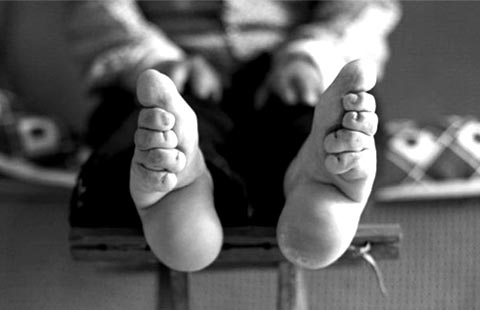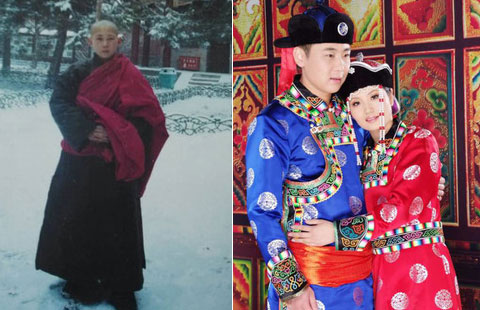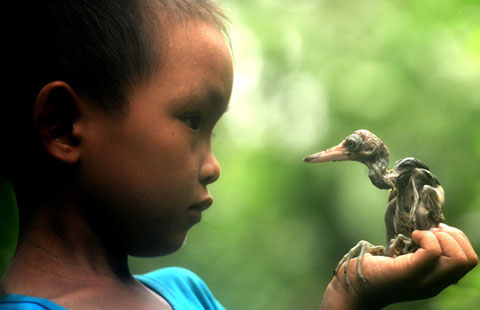Colorblind cartoonist thrives in art
Updated: 2014-08-02 07:43
By Zhang Lei (China Daily)
|
|||||||||
The Chinese Dream | Lin Ji
Descendant of one of the most famous Lin families overcomes obstacles in pursuit of her dream.
Two months ago, the creator of the popular cartoon character Ghost, who works under the nom de plume Viviling, published a new book We Still Need Dreams, But What If They Come True? in which the character relates the author's own coming-of-age stories in humorous fashion.
|
Lin Ji injects her own coming-of-age stories into the adventures of her cartoon character Ghost, cute, nightcap-sporting elf who is generating love and positive energy on the Chinese Internet. Provided to China Daily |
Viviling, whose real name is Lin Ji, is a 28-year-old Beijinger. The name "Ji" means "to remember" in Chinese: "My father gave me this name, because he wanted me to remember the history of the Lin family," says the seventh-generation direct descendant of Lin Zexu, a commissioner and grand scholar during the Qing Dynasty (1644-1911), whose confiscation and destruction of opium in Humen, Guangdong province, precipitated the First Opium War (1839-42).
In the new book, Lin tells seven stories related to her own adolescence, each of which corresponds to the seven colors of the rainbow and represent hope, warmth, patience, dreams, tolerance, wisdom, and growth. It's a book about dreams and love.
However, despite her penchant for colors , she is colorblind, which has challenged her artistic pursuit all along.
Although she loves painting, she often finds it difficult to select the correct color. All of her childhood paintings were rendered in black and white, which led to mockery from her classmates and left her with low self-esteem.
"I don't remember when I started to draw. When I was a kid my family was poor, and I didn't have many toys. One day, my mother saw me copying drawings from a picture book, so she bought me a lot of pencils. Every time I finished a picture, I stuck it on the wall, and soon the whole house was covered. So, my childhood memories are all about painting," Lin says.
By the time when she graduated from college, Lin was determined to become a professional cartoonist.

So after working for several years as a designer in the online games industry, she started to draw a cartoon character that would be easily acceptable and memorable to ordinary readers.
Her most successful creation, Ghost, is a cute, nightcap-sporting elf that is generating love and positive energy on the Chinese Internet. When the cartoon character first appeared in April 2012, his devilish, yet oddly innocent look instantly struck a chord with many young lovers of manga, a type of graphic novel most closely associated with Japan.
The character often speaks in a tone that drips with mock sympathy - which the audience loves - and although his official name is "Ghost", he prefers to be called Oppa - "big brother" in Korean. The term is becoming increasingly popular in China, mainly as a result of people mimicking the pouting girls in Korean soap operas who use the word to describe their boyfriends.
"Starting at elementary school, I began to read books by Japanese masters such as Akira Toriyama, Fujiko Fujio, Rumiko Takahashi. Unlike many Chinese parents, my mom never stopped me from buying comics and watching cartoons, which was very fortunate. In middle school, I started to publish short stories in the magazine Beijing Cartoons. My favorite comics are Kindaichi series," she says referring to a Japanese manga series that stars a crime-solving high school student.
"I made Ghost a boy, because my own character is really boyish. I also incorporated some of the basic elements of the ideal boyfriend from my own imagination - he's funny, cute and very caring: traits that can be regarded as ideal boyfriend material.
"Drawing is actually a very lonely job. One has to sit at a desk with no communication with other people. This is a one-woman show, so I put all that I want to say and express in my cartoons. I hope they bring people some joy," she says.
When her father passed away suddenly in 1999, Lin found it difficult to adjust to life without him.
"I was depressed for a long time. I didn't want to talk and I was like a zombie. At times like that, no one can help, you just have to wait for the feeling to pass. A few months later, I was packing up some of his papers when I suddenly noticed something he'd written: 'I have had a rough life, but I'm very fortunate to have this only daughter. I hope she will grow up healthy, honest and tolerant.' I burst into tears, but then all of a sudden I felt that by continuing to be depressed I would only disappoint my father," she said.
One day she saw a post online: "Every man has a particular time he wants to return to". For Lin, that moment is 1999, when her father was still alive, so she could cherish the moments with him. That feeling was the genesis of her first comic series Back to 1999.
"I see purple in it - it's a color that represents growth. Everyone wants to return to a particular time in their life because there's something there you can never put aside," she said.
"I have always felt that the essence of life lies in hustle and bustle - the need to continue to do something - to energize a dull day, to enjoy the feeling of really living. For example, traveling to places far and wide, but also mundane things such as slavishly looking after my beloved cat."
In 2010, Lin and several colleagues opened the MIUCafe, a cat-themed cafe in Fuzhou, Fujian province, and earlier this year, she opened a Ghost- themed cafe there. Her aim now is to establish a chain of cafes nationwide.
Lin's account on Sina Weibo, China's version of Twitter, has nearly 3.9 million followers, and each of the comic strips she has posted online has been forwarded 100,000 times on average. "Drawing comic strips is really nerve-racking most of the time, but inspiration often comes unexpectedly after a period of writer's block, and it's incredibly cathartic - that's why I call my cartoon career a 'sweet torture'. No matter, I'm addicted and will never grow tired of it."
Contact the reporter at: zhanglei@chinadaily.com.cn

(China Daily 08/02/2014 page16)
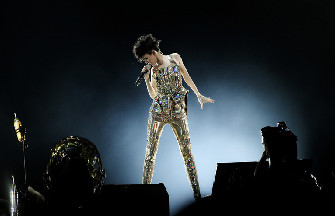
 Star Stefanie Sun holds concert in Beijing
Star Stefanie Sun holds concert in Beijing
 Faye Wong's manager refutes star's drug rumors
Faye Wong's manager refutes star's drug rumors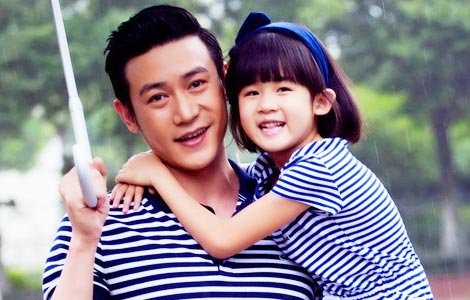
 Lu Yi and daughter Bei Er pose for street snaps
Lu Yi and daughter Bei Er pose for street snaps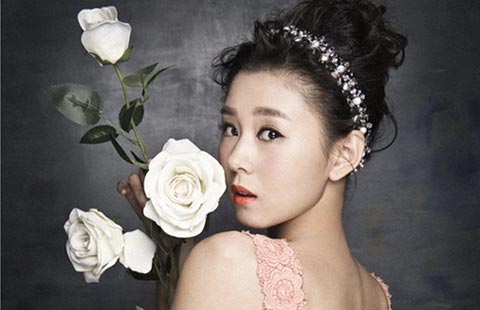
 Photoshoots of actress Li Xiaomeng
Photoshoots of actress Li Xiaomeng
 Council of Fashion Designers of America Awards
Council of Fashion Designers of America Awards
 Fan Bingbing, first Chinese actress in Barbie Hall of Fame
Fan Bingbing, first Chinese actress in Barbie Hall of Fame
 Awarding ceremony of 2014 hito Pop Music held in Taipei
Awarding ceremony of 2014 hito Pop Music held in Taipei
 Zhao Liying's photo shoot for Children's Day
Zhao Liying's photo shoot for Children's Day
Most Viewed
Editor's Picks

|

|

|

|

|

|
Today's Top News
'Military drill isn't targeting any nation'
Snyder back to China to lure biz
Multinational bribery cases on rise
Alibaba may buoy mobile portfolio
'Drill isn't targeting any nation'
Imam murdered in Xinjiang
Reforming hukou will unify rights of migrants
Oil stocks rally on news of probe
US Weekly

|

|



